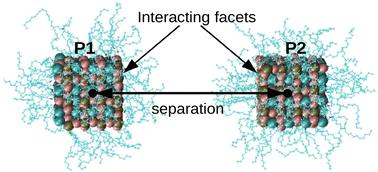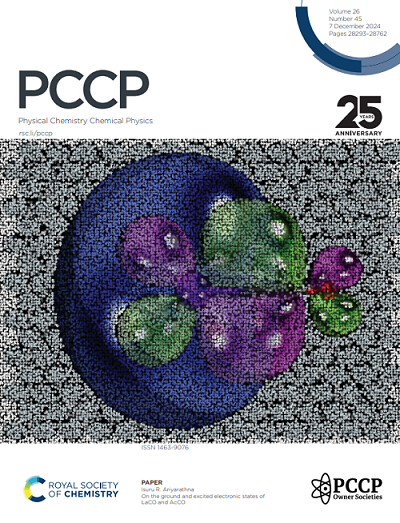Ligand-mediated interaction in a dispersion of lead-halide perovskite nanocubes: implications on directed structures in equilibrium
IF 2.9
3区 化学
Q3 CHEMISTRY, PHYSICAL
引用次数: 0
Abstract
Motivated by the experimental reports on the formation of ordered nano-structures of ligand-dressed Cs–Pb-halide nanoparticles, employing a combination of density functional theory, molecular dynamics, metadynamics and Monte Carlo simulation techniques, we investigate the microscopic mechanism driving such structures. Our rigorous studies focused on CsPbBr3 nanoparticles take into account the realistic situation in terms of different synthesis conditions. In particular, Br vacancies, the neutral and charged forms of ligands, and the presence of a variety of solvents of different polarities are considered. Our work establishes the crucial role of electrostatics driving preferential matching of facets paving the way to the formation of directed structures. In particular, the importance of Br vacancies, the polarity of solvents, and the preference for slightly alkaline synthesis conditions are highlighted. The microscopic understanding thus provided will be useful in designing targeted nano-structures.

求助全文
约1分钟内获得全文
求助全文
来源期刊

Physical Chemistry Chemical Physics
化学-物理:原子、分子和化学物理
CiteScore
5.50
自引率
9.10%
发文量
2675
审稿时长
2.0 months
期刊介绍:
Physical Chemistry Chemical Physics (PCCP) is an international journal co-owned by 19 physical chemistry and physics societies from around the world. This journal publishes original, cutting-edge research in physical chemistry, chemical physics and biophysical chemistry. To be suitable for publication in PCCP, articles must include significant innovation and/or insight into physical chemistry; this is the most important criterion that reviewers and Editors will judge against when evaluating submissions.
The journal has a broad scope and welcomes contributions spanning experiment, theory, computation and data science. Topical coverage includes spectroscopy, dynamics, kinetics, statistical mechanics, thermodynamics, electrochemistry, catalysis, surface science, quantum mechanics, quantum computing and machine learning. Interdisciplinary research areas such as polymers and soft matter, materials, nanoscience, energy, surfaces/interfaces, and biophysical chemistry are welcomed if they demonstrate significant innovation and/or insight into physical chemistry. Joined experimental/theoretical studies are particularly appreciated when complementary and based on up-to-date approaches.
 求助内容:
求助内容: 应助结果提醒方式:
应助结果提醒方式:


